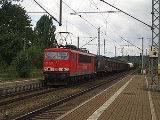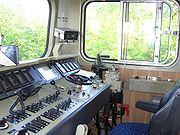
DR Class 250
Encyclopedia
The Deutsche Reichsbahn (East Germany) Class 250 (known since 1992 as Deutsche Bahn AG Class 155) is a German electric locomotive
used on freight trains. Nicknamed the “Electric Container
” or “Powercontainer” due to its distinctive carbody shape. The less favorable nickname “Stasi
-Container” is also heard every now and then. It was the most powerful locomotive in the former GDR.
built a new, 6-axled, electric locomotive suitable for all classes of traffic. In 1974 three prototypes were built by LEW Hennigsdorf
, the leading builder of railway locomotives in the GDR. A series of 270 locomotives were delivered between 1977 and 1984. They were mainly used for heavy cargo trains as well as the fast Städteexpress-train services of DR (comparable with InterCity
).
After the reunification of Germany, railway traffic in East Germany slumped. The locomotives were renumbered as class 155, and many of them also operated in West Germany. After Deutsche Bahn
was restructured, the engines were assigned to DB Cargo (later Railion, now DB Schenker Rail) for freight services. Since 1998, some locomotives have been used for spare parts. Approximately 200 are still in existence and can be seen throughout Germany pulling all sorts of freight trains. Today the 155s remain indispensable for DB Schenker, Deutsche Bahn
's railway cargo carrier.
s. Each axle is powered by a single-phase, series-wound, AC motor
. The torque is transferred by a double-sided spur gear to a hollow shaft
, and by an elastic rubber cone flange to the wheels. Each motor has an own cooling blower.
Two scissor-shaped pantographs collect the current of 15 kV / 16.7 Hz from the catenary
. Recently, many of these pick-ups have been refitted as modern single-arm pantograph
s.
The core of the electric system is the 3-blade main transformer
with oil-cooling. The control unit has 30 power notches, semi-automatic in operation. The settings are thyristor
controlled and the thyristor voltage is regulated by phase cutting, which was a novelty for series locomotives in the GDR. All units are equipped with a catenery-current-controlled electric brake. The safety equipment in the driver's cab has an electronic deadman's brake (Sifa
), “punctiform” automatic train controls (PZB 90), and train radio equipment with GSM-R
communication. Relatively recently, computers were added for the electronic timetable EBuLa.
Some of the models have been equipped with the LZB
System. Recently, these are used to haul heavy and fast container trains on the German high-speed network
.

Electric locomotive
An electric locomotive is a locomotive powered by electricity from overhead lines, a third rail or an on-board energy storage device...
used on freight trains. Nicknamed the “Electric Container
Intermodal container
An intermodal container is a standardized reusable steel box used for the safe, efficient and secure storage and movement of materials and products within a global containerized intermodal freight transport system...
” or “Powercontainer” due to its distinctive carbody shape. The less favorable nickname “Stasi
Stasi
The Ministry for State Security The Ministry for State Security The Ministry for State Security (German: Ministerium für Staatssicherheit (MfS), commonly known as the Stasi (abbreviation , literally State Security), was the official state security service of East Germany. The MfS was headquartered...
-Container” is also heard every now and then. It was the most powerful locomotive in the former GDR.
History
In the mid-1960s, it became apparent that engine classes 211 and 242, in production since 1961, were not powerful enough, so DRDeutsche Reichsbahn of the GDR
The Deutsche Reichsbahn or DR was the operating name of state owned railways in the German Democratic Republic ....
built a new, 6-axled, electric locomotive suitable for all classes of traffic. In 1974 three prototypes were built by LEW Hennigsdorf
LEW Hennigsdorf
The rail vehicle factory in Hennigsdorf, Germany was founded in 1910 by AEG. Locomotive production began in 1913, and in the 1930s absorbed the work of the August Borsig locomotive factory, being renamed the Borsig Lokomotiv Werke GmbH until 1944...
, the leading builder of railway locomotives in the GDR. A series of 270 locomotives were delivered between 1977 and 1984. They were mainly used for heavy cargo trains as well as the fast Städteexpress-train services of DR (comparable with InterCity
Intercity (Deutsche Bahn)
Intercity is the second-highest train classification in Germany, after the ICE. Intercity services are loco-hauled express services, usually over long-distances. There are Intercity routes throughout Germany, and routes generally operate with a two-hour frequency, with multiple routes giving a more...
).
After the reunification of Germany, railway traffic in East Germany slumped. The locomotives were renumbered as class 155, and many of them also operated in West Germany. After Deutsche Bahn
Deutsche Bahn
Deutsche Bahn AG is the German national railway company, a private joint stock company . Headquartered in Berlin, it came into existence in 1994 as the successor to the former state railways of Germany, the Deutsche Bundesbahn of West Germany and the Deutsche Reichsbahn of East Germany...
was restructured, the engines were assigned to DB Cargo (later Railion, now DB Schenker Rail) for freight services. Since 1998, some locomotives have been used for spare parts. Approximately 200 are still in existence and can be seen throughout Germany pulling all sorts of freight trains. Today the 155s remain indispensable for DB Schenker, Deutsche Bahn
Deutsche Bahn
Deutsche Bahn AG is the German national railway company, a private joint stock company . Headquartered in Berlin, it came into existence in 1994 as the successor to the former state railways of Germany, the Deutsche Bundesbahn of West Germany and the Deutsche Reichsbahn of East Germany...
's railway cargo carrier.
Construction
The locomotives have two 3-axled bogieBogie
A bogie is a wheeled wagon or trolley. In mechanics terms, a bogie is a chassis or framework carrying wheels, attached to a vehicle. It can be fixed in place, as on a cargo truck, mounted on a swivel, as on a railway carriage/car or locomotive, or sprung as in the suspension of a caterpillar...
s. Each axle is powered by a single-phase, series-wound, AC motor
Electric motor
An electric motor converts electrical energy into mechanical energy.Most electric motors operate through the interaction of magnetic fields and current-carrying conductors to generate force...
. The torque is transferred by a double-sided spur gear to a hollow shaft
Quill drive
A quill drive is a mechanism that allows a drive shaft to shift its position relative to its driving shaft. It consists of a hollow driving shaft with a driven shaft inside it...
, and by an elastic rubber cone flange to the wheels. Each motor has an own cooling blower.
Two scissor-shaped pantographs collect the current of 15 kV / 16.7 Hz from the catenary
Overhead lines
Overhead lines or overhead wires are used to transmit electrical energy to trams, trolleybuses or trains at a distance from the energy supply point...
. Recently, many of these pick-ups have been refitted as modern single-arm pantograph
Pantograph (rail)
A pantograph for rail lines is a hinged electric-rod device that collects electric current from overhead lines for electric trains or trams. The pantograph typically connects to a one-wire line, with the track acting as the ground wire...
s.
The core of the electric system is the 3-blade main transformer
Transformer
A transformer is a device that transfers electrical energy from one circuit to another through inductively coupled conductors—the transformer's coils. A varying current in the first or primary winding creates a varying magnetic flux in the transformer's core and thus a varying magnetic field...
with oil-cooling. The control unit has 30 power notches, semi-automatic in operation. The settings are thyristor
Thyristor
A thyristor is a solid-state semiconductor device with four layers of alternating N and P-type material. They act as bistable switches, conducting when their gate receives a current trigger, and continue to conduct while they are forward biased .Some sources define silicon controlled rectifiers and...
controlled and the thyristor voltage is regulated by phase cutting, which was a novelty for series locomotives in the GDR. All units are equipped with a catenery-current-controlled electric brake. The safety equipment in the driver's cab has an electronic deadman's brake (Sifa
Sifa
Sifa or the deadman's control system is a safety device in a train intended to bring the train automatically to a stop if the driver becomes incapacitated.-Description:...
), “punctiform” automatic train controls (PZB 90), and train radio equipment with GSM-R
GSM-R
GSM-R, Global System for Mobile Communications - Railway or GSM-Railway is an international wireless communications standard for railway communication and applications. A sub-system of European Rail Traffic Management System , it is used for communication between train and railway regulation...
communication. Relatively recently, computers were added for the electronic timetable EBuLa.
Some of the models have been equipped with the LZB
Linienzugbeeinflussung
Linienzugbeeinflussung is a cab signalling andtrain protection system used on selected German and Austrian railway linesas well as the AVE in Spain.In Germany, the system is mandatory on all lines where trains exceed speeds of...
System. Recently, these are used to haul heavy and fast container trains on the German high-speed network
High-speed rail in Germany
Construction on the first German high-speed lines began shortly after that of the French LGVs . Legal battles caused significant delays, so that the InterCityExpress trains were deployed ten years after the TGV network was established...
.


